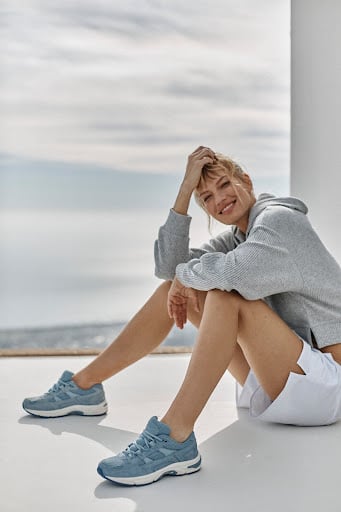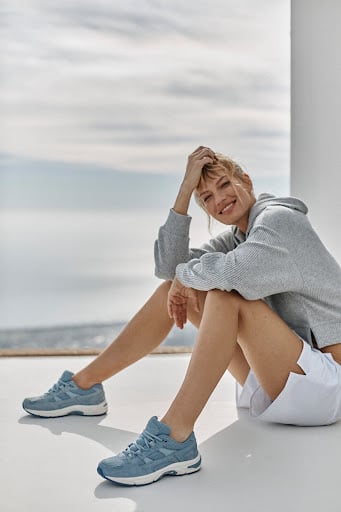There are so many advantages of a physically active lifestyle—it can lower stress levels, improve brain health,1 and in best-case scenarios, you can discover new passions that you can take with you wherever you go. Similarly, there’s something special about buying a fresh pair of athletic shoes. With every new pair comes a renewed sense of confidence and comfort. After all, you’ve worn down your old pair from all that healthy exercise—a new pair should be celebrated!
Yet when you slip into that new pair, you may notice it doesn’t fit quite as well as your older, worn-in pair. This could be because of the shoe cushioning.
Shoe cushioning is the thick (or thin) comfortable layer of padding between your foot and the ground. As you can imagine, thicker shoe cushions can feel like walking on clouds, while “barefoot shoes” allow your feet to feel every crack and pebble in the road.
How do you know how much shoe cushioning is right for you? Let’s break down everything you need to know to help you identify the perfect level of comfort.
Shoe Cushioning: A Full Breakdown
Shoe cushioning refers to how much thickness is in the midsole of a shoe. More cushion equates to more support while less cushion means that you’re more likely to feel as though you’re walking barefoot (with just a sole to keep your feet safe). It’s one of the key factors to consider when determining how to choose the best performance shoes for your feet.
Here’s a quick breakdown of the different types of shoe cushioning:
- Lightweight – Without the added arch support of cushioning, your feet are flatter and closer to the ground in lightweight shoes. This allows for a more natural motion in your feet as you walk. Lightweight cushioning is ideal for strengthening the foot and ankle naturally and allowing you to stay light on your feet. For example, rock climbers want to feel the subtle ridges on a rockface, so they prefer lightweight cushioning.
- Moderate – This is the “go-to” cushioning for a lot of active sneakers as it provides a medium level of support in the midsole but not so much that you feel like you’re stepping on a marshmallow.
- Maximum – If you’re looking for plush, pillow-like cushioning for your feet, you might appreciate the most robust amount of cushioning. Long-distance walkers and hikers, as well as individuals with foot or knee injuries, often opt for maximum cushioning as it provides the highest level of support and may reduce the impact of your steps.
How Does Shoe Cushioning Work?
When your feet hit the ground as you walk or hike, the shock of each strike creates a vibration throughout your body. It starts at the point of impact and works its way up your frame.
While you may not be aware, you come equipped with your very own DIY cushioning system to reduce the shock from movement. Other than shock absorption, this internal cushioning system helps you perform at your best so that you can exercise with little to no constraints. These DIY processes occur subconsciously in the form of changing your posture or adjusting the amount of pressure you’re placing on your feet during each strike.
Of course, your performance shoes wouldn’t leave you to combat each blow on your own. They incorporate their own cushioning system to absorb some of the shock as well.
To that end, shoe cushioning works to decrease the strain placed on your body during each walking strike. This helps you move at full power while alleviating some of the shock to your bones, muscles, and joints so they don’t feel as much of the impact.
Why Is Shoe Cushioning Important?
The main role of shoe cushioning is to absorb some of the shock to your body as you walk, jump, and pivot (depending on your exercise of choice). Ideally, the more cushioning your shoes have, the more support they provide, leaving you with fewer chances of a potential injury.
In a recent study, collegiate basketball players performed multiple trials of drop jumps in athletic shoes of varying cushion levels.2 They completed the first trial with a fresh set of muscles. Then, they performed the second trial after their muscles were already in a state of fatigue.
The results showed that high-cushioned shoes have the potential to reduce landing-related rearfoot impact, especially in post-fatigued muscles.2 This could provide much-needed support to athletes of all backgrounds, especially those participating in long-distance hikes or walks.
How to Choose The Right Shoe Cushioning Level for You
Not every shoe size is going to fit your foot. Similarly, there’s no one-size-fits-all approach to figuring out the right amount of shoe cushioning. It all comes down to finding the perfect balance of cushion for your feet and your performance needs.
Here are some important factors to consider that may help you determine the right shoe cushioning level for you.
Know Your Terrain
Will you be working out on a hard basketball court, walking on park grass, or hiking up cliffsides? Understanding different terrains can be a deciding factor in how much shoe cushioning you choose.
Some of the common outdoor terrains include:
- Grass – Exercising in the grass does more than ground you with Mother Nature—although that is a plus. Grass provides a soft terrain with a less severe impact, so athletic shoes with minimal cushioning are an excellent option for this terrain.
- Sand – Who doesn’t love a morning waltz on the beach, soaking in the fresh salt air and a burst of mid-morning endorphins? If this sounds like you, consider the type of sand you’re walking on before choosing a level of cushioning. The stability of packed sand makes it perfect for moderately cushioned shoes, while loose sand is ideal for less cushioning.
- Cement – This extremely solid terrain can have a high impact on your body while exercising, so shoes with maximum cushioning are more likely to provide you with extra shock support.
- Trail – From rocky gravel to leafy underbrush, there are a variety of terrains under the umbrella of hiking. So, the shoes you choose will vary depending on the type of trail you’re on. Generally, a hard-packed surface works well with a shoe that provides moderate cushioning.
Consider the Distance
Another important consideration is what your fitness routine looks like: Are you training for a marathon, or do you exercise for 30 minutes throughout the week as one part of a holistic healthy lifestyle?
If you’re an advanced hiker or walker, highly cushioned shoes may improve your performance by providing more thorough arch support throughout. A little extra cushion may keep the muscle fatigue at bay for slightly longer by absorbing some of the impact and helping your muscles to function properly through every foot strike.
On the other hand, if you walk around the block twice a day to stay nimble, low-cushioned shoes might be the way to go since it’s less likely that the muscles in your feet or legs will become fatigued.
When to Incorporate Shoes with Cushions
To wear the cushions or not to wear the cushions? That is the question. There are plenty of benefits of wearing performance shoes that include a moderate amount of cushioning, like:
- Decreasing your chances of injuries
- Providing arch support
- Adding a dash of midsole cushioning to reduce stress on the heels and ankles
But are shoes with cushions a must for all occasions?
Not exactly. It depends on your preferences and the type of exercise you prefer. If you’re still unsure, here are a few types of athletes who are likely to benefit from wearing shoes with cushions:
- New athlete – When you’re still learning the ropes, it can be helpful to give yourself a little grace (i.e., extra cushioning). Consider investing in a pair with moderate cushiness while you perfect your walking form and allow your muscles to adjust to the demands of long-term exercise.
- Athletes with injuries – Whether you’re recovering from plantar fasciitis, shin splints, or another injury altogether, you can never have too much cushion while you get back in the swing of things. A moderate amount of cushion can give you the support you need while you retrain your muscles.
- Advanced athletes – If you’re an athlete who really goes the distance, a pair of cushioned performance shoes can support your foot’s rolling movement, even as it tires out. This gives you a better chance to continue performing without sacrificing poor form and expending too much energy.
Take Your Exercise to the Next Level with Vionic
Every athlete’s form is unique. That’s why it’s essential to provide yourself with the perfect amount of cushion for your needs. When it’s time to begin the search for your next pair of performance shoes, you can count on Vionic to give you the ultimate support, whether you’re looking for minimal cushioning or the ultimate foot pillow.
No matter your preferences, we’ve created active sneakers that seamlessly blend science with style. Our athletic shoes contain a podiatrist-designed orthotic with a flexible cushioned outsole, so you have the support and comfort you need for work, play, and everyday wear.
From casual to laceless adjustable sneakers (and everything in between), browse our collection to find your next pair of perfectly cushioned athletic shoes today.
Sources:
- “Benefits of Physical Activity.” CDC. https://www.cdc.gov/physicalactivity/basics/pa-health/index.htm
- Wang, Xi et al. “Wearing Cushioning Shoes Reduce Load Rates More Effectively in Post-Fatigue than in Pre-Fatigue during Landings.” Biology vol. 10,10 962. 26 Sep. 2021, doi:10.3390/biology10100962
- “The Truth Behind ‘Runner’s High’ and Other Mental Benefits of Running.” John Hopkins Medicine. https://www.hopkinsmedicine.org/health/wellness-and-prevention/the-truth-behind-runners-high-and-other-mental-benefits-of-running
- Black, Matthew I et al. “Highly Cushioned Shoes Improve Running Performance in Both the Absence and Presence of Muscle Damage.” Medicine and science in sports and exercise vol. 54,4 (2022): 633-645. doi:10.1249/MSS.0000000000002832

